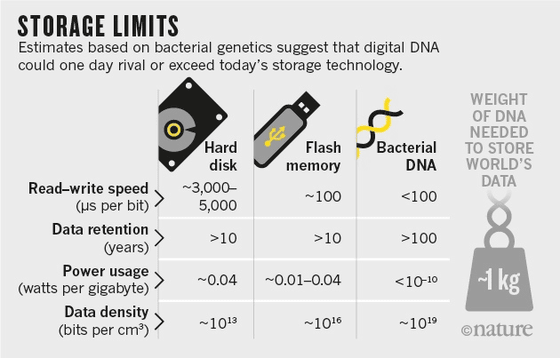What is "DNA storage", which can store worldwide data with ultra-high capacity exceeding the hard disk, low maintenance cost?

ByAndy Leppard
Recently attracted attention due to the rapid increase of digital data is to use DNA as a storage (external storage device) to store data. However, preserving data in DNA is somewhat unintelligible, and has been studying bioinformatics for a long time in detailEuropean Bioinformatics LaboratoryIt is open to the public.
How DNA could store all the world's data: Nature News & Comment
http://www.nature.com/news/how-dna-could-store-all-the-world-s-data-1.20496
Digital data existing on the Internet is rapidly increasing, and it is estimated that by 2020 it will reach an amount that can not be imagined, 44 trillion GB. About 44 trillion GB is about ten times as much as all the digital data stored by 2013, and there arises a problem that it takes too much cost to keep so much data in the data center and so on. As storage that stores increasing digital data, DNA is attracting attention in recent years as a change to hard disk.
The following table published by Nature is a table comparing the reading / writing speed, storage period, power usage amount and recording density of hard disk, flash memory, and DNA. For example, looking at the second row of the table, the storage period of the hard disk and flash memory is over 10 years, but DNA has more than 100 years. Also in terms of power usage and recording density DNA has recorded superior numerical values than hard disk and flash memory.

DNA isNucoretideThe nucleotide is a combination of a nucleotide of a compound having a base and a sugar bound to phosphoric acid. Because the sequence of three bases contained in this nucleotide gives rise to genetic features, DNA is sometimes referred to as a life plan. Genetic data necessary for living in human DNA has been continuously preserved from the birth of human beings, and it can be said that it is huge storage.
Research on preserving a large amount of data by scientific synthesis of this DNA has been actively conducted in recent years. In 2013, the European Bioinformatics Research Institute succeeded in preserving by encoding data stored in 4 file formats such as PDF · MP3 · JPEG · TEXT into a DNA array. In addition, in April 2016, Microsoft will become a company called Twist Bioscience which studies DNA storageStated investment, And a short nucleotide "20 base pairs or less in length"Oligonucleotide"There were talks to buy 10 million individuals for encoding technology development.
How to keep in mind how to store data in DNA. It is necessary to encode to store data in DNA, but this encoding method differs for each laboratory. The European Bioinformatics Laboratory is publishing a new encoding method adopted in place of the conventional method which was prone to error at the time of storage. According to the document, for example, the text data is converted into a binary code composed of "0" and "1" ...

Convert the converted binary code to triplet code consisting of three "0" "1" "2". This triplet code is an array of three bases corresponding to amino acids.

Now we build a helical structure of DNA using triplet code consisting of '0', '1' and '2' as the design document.

Finally, we made several helical structures of DNA with one 100 bases, compare it with 25, 50, 75 bases and compare them. It seems that it is easy to detect and repair errors by storing part of 100 bases of DNA in duplicate.

Using the method developed by the European Bioinformatics Research Institute, it is possible to quickly identify and repair errors that occur during storage, but the problem is the speed of encoding. Because it uses a special algorithm, even data that can be saved in hard disk in seconds can take several hours to save in DNA, it seems that it takes time to decode about decoding as common sense.
Nick Goldman, director of the European Bioinformatics Research Institute, said, "There are one or two new technologies concerning data preservation appearing every year, waiting a little more, although there are still many problems to be able to use DNA as storage. I will confront the problem of speed. "
Related Posts:
in Science, Posted by darkhorse_log







